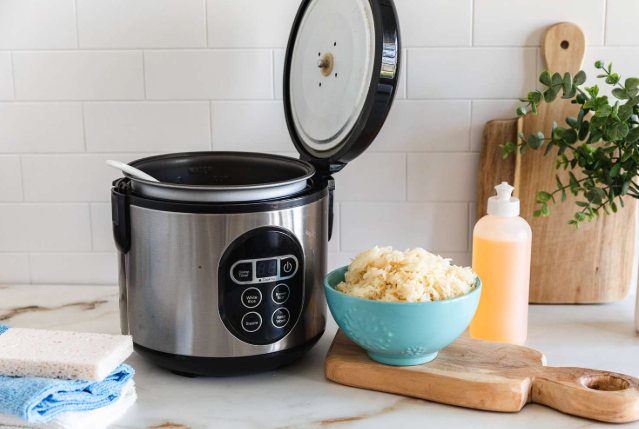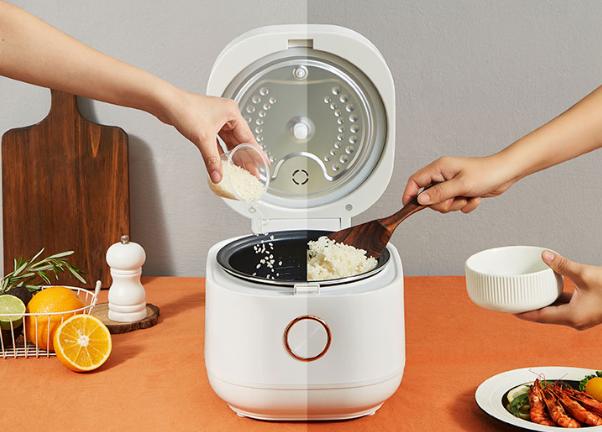Learning how to cook rice in electric cooker models can transform your meal prep, delivering perfectly fluffy rice with minimal effort. Electric cookers, such as pressure cookers or multicookers, streamline the process, saving time and ensuring consistent results. Whether you’re a beginner or a seasoned cook, this comprehensive guide will walk you through the steps, tips, and tricks for mastering rice in an electric cooker. From cooker setup to cooker troubleshooting, we’ll cover everything you need to know to achieve restaurant-quality rice at home. Let’s get started with this best cooker guide!
Why Use an Electric Cooker for Rice?
An electric cooker is a versatile kitchen appliance that simplifies cooking rice. Unlike stovetop methods, which require constant monitoring, electric cookers automate the process with precise temperature and pressure controls. This makes them ideal for busy households or anyone seeking a portable cooker for quick, reliable meals. Models like the Cuisinart CPC-600 or Instant Pot Duo offer dedicated rice settings or pressure cooking modes that ensure perfect texture, whether you’re cooking white rice, brown rice, or specialty grains like jasmine or basmati.
In this article, we’ll focus on how to use electric cooker models to cook rice, including setup, cooking techniques, and cooker maintenance tips to keep your appliance in top shape. For more insights on electric cookers, check out this electric cooker guide.

Types of Rice and Electric Cooker Compatibility
Before diving into how to cook rice in electric cooker, it’s important to understand the types of rice and how they perform in an electric cooker:
- White Rice: Cooks quickly (4–7 minutes under pressure) and yields a soft, fluffy texture. Ideal for beginners.
- Brown Rice: Requires longer cooking times (20–25 minutes) due to its bran layer but offers a nutty flavor and chewy texture.
- Jasmine or Basmati: Fragrant long-grain varieties that cook in 4–6 minutes, perfect for Asian or Indian dishes.
- Wild Rice: Takes 25–30 minutes and pairs well with pressure cooking for consistent results.
- Sushi Rice: A short-grain variety that needs precise water ratios for sticky, cohesive texture.
Most electric cookers, like the Cuisinart or Instant Pot, have a rice setting or allow manual pressure adjustments, making them suitable for all these varieties. Always check your cooker’s manual for specific recommendations.
Step-by-Step Guide: How to Cook Rice in Electric Cooker
Follow these steps to master how to cook rice in electric cooker for perfect results every time:
Step 1: Gather Your Ingredients and Tools
- Rice (white, brown, jasmine, etc.)
- Water or broth (for added flavor)
- Measuring cup (use the one included with your cooker for accuracy)
- Electric cooker (e.g., Cuisinart CPC-600 or Instant Pot)
- Optional: salt, butter, or oil for flavor
Step 2: Rinse the Rice
Rinsing removes excess starch, preventing gummy rice. Place the rice in a fine-mesh strainer and rinse under cold water until the water runs clear (about 1–2 minutes). This step is especially important for white, jasmine, or basmati rice.
Step 3: Measure Water and Rice
The water-to-rice ratio varies by rice type and cooker model. As a general guide:
- White Rice: 1 cup rice to 1–1.25 cups water
- Brown Rice: 1 cup rice to 1.5 cups water
- Jasmine/Basmati: 1 cup rice to 1 cup water
- Wild Rice: 1 cup rice to 2 cups water
Check your cooker’s manual, as some models (like the Instant Pot) require slightly less water due to minimal evaporation. For richer flavor, substitute water with broth or add a pinch of salt.
Step 4: Set Up the Cooker
Proper cooker setup ensures smooth operation:
- Place the rinsed rice and measured water in the cooker’s nonstick pot.
- Add a teaspoon of oil or butter (optional) to reduce foaming and sticking.
- Ensure the pot is properly seated in the cooker base.
- Secure the lid and set the pressure valve to the “sealing” or “pressure” position.
Step 5: Select the Cooking Mode
Most electric cookers have a dedicated rice setting or allow manual pressure adjustments. Here’s how to proceed:
- Rice Setting: Select the “Rice” mode for white or jasmine rice. This typically cooks at low pressure for 4–7 minutes.
- Manual Pressure: For brown or wild rice, use high pressure and adjust the time (e.g., 20–25 minutes for brown rice).
- Slow Cook Mode: If your cooker (like the Cuisinart MSC-600) lacks a rice setting, use the slow cook mode for 1–2 hours, mimicking a traditional rice cooker.
Press “Start” to begin the cooking cycle. The cooker will take 5–10 minutes to build pressure before the timer starts.
Step 6: Release Pressure
After cooking, choose one of these pressure release methods:
- Natural Release: Let the pressure drop naturally (10–15 minutes) for fluffier rice.
- Quick Release: Manually release steam by turning the valve to “venting” (use caution to avoid burns). This is faster but may result in slightly wetter rice.
Step 7: Fluff and Serve
Once pressure is released, open the lid, fluff the rice with a fork, and let it sit for 1–2 minutes to absorb residual steam. Serve immediately or keep warm using the cooker’s “Keep Warm” function.
For more detailed instructions and recipe ideas, explore this cooker guide.
Cooker Tips for Perfect Rice
Here are some cooker tips to elevate your rice-cooking game:
- Adjust for Altitude: At higher altitudes, increase cooking time by 5–10% to account for lower air pressure.
- Use Broth for Flavor: Replace water with chicken, vegetable, or beef broth for richer rice.
- Add Aromatics: Toss in a bay leaf, garlic clove, or ginger slice for subtle flavor infusion.
- Avoid Overfilling: Fill the pot no more than halfway to prevent clogging the pressure valve, ensuring cooker safety.
- Experiment with Ratios: If rice is too wet or dry, tweak the water ratio slightly (e.g., reduce by ¼ cup for drier rice).

Cooker Maintenance for Long-Lasting Performance
Proper cooker maintenance ensures your electric cooker performs well for years. Follow these steps after cooking rice:
- Clean the Pot: Wash the nonstick pot with warm, soapy water or place it in the dishwasher if safe. Avoid abrasive scrubbers to preserve the coating.
- Check the Sealing Ring: Rice starch can stick to the silicone gasket. Soak it in warm water with baking soda to remove odors.
- Inspect Valves: Ensure the pressure and float valves are free of rice grains or starch buildup to prevent clogs.
- Wipe the Exterior: Clean the cooker’s exterior and lid with a damp cloth to remove splatters.
- Store Properly: Keep the cooker in a dry, cool place, with the lid loosely placed to allow airflow and prevent mold.
Regular maintenance extends your cooker’s lifespan and prevents issues during future use. Replacement parts, like sealing rings or pots, are affordable and widely available.
Cooker Safety When Cooking Rice
Cooker safety is critical when using an electric cooker. Here are key precautions:
- Check the Lid: Ensure the lid is locked and the pressure valve is set correctly before starting.
- Avoid Overfilling: Excess rice or water can clog the valve, causing pressure issues.
- Handle Steam Carefully: Use a long utensil to turn the pressure valve during quick release to avoid burns.
- Use a Stable Power Source: Ensure your cooker is plugged into a reliable outlet, as power fluctuations can affect performance.
These measures make cooking rice safe and hassle-free, even for beginners.
Cooker Troubleshooting: Common Rice-Cooking Issues
If you encounter problems while learning how to cook rice in electric cooker, these cooker troubleshooting tips can help:
- Rice Too Wet: Reduce water by ¼ cup or extend natural pressure release time to allow excess moisture to evaporate.
- Rice Too Dry: Increase water by ¼ cup or shorten cooking time slightly.
- Burn Warning: This may occur if there’s insufficient liquid or rice sticks to the pot. Ensure proper water ratios and clean the pot thoroughly.
- Slow Pressure Buildup: Check for a worn sealing ring or clogged valve. Replace the ring if needed (costing ~$10).
- Uneven Cooking: Stir rice before cooking to distribute water evenly, and ensure the pot is properly seated.
If issues persist, consult your cooker’s manual or online forums for model-specific advice.
Power Considerations for Electric Cookers
Electric cookers don’t rely on cooker battery life but require a stable power source (typically 1000–1200 watts). For off-grid use (e.g., camping or RV living), ensure your power setup can handle the cooker’s energy demands. Some users note that solar or wind power may not suffice without a generator, so plan accordingly.
Benefits of Cooking Rice in an Electric Cooker
Mastering how to cook rice in electric cooker offers several advantages:
- Time-Saving: Pressure cooking cuts rice cooking time significantly (e.g., white rice in 4–7 minutes vs. 20–30 minutes on the stovetop).
- Consistency: Automated settings ensure uniform results without constant monitoring.
- Versatility: Cook various rice types or combine rice with other ingredients (e.g., beans or vegetables) in one pot.
- Energy Efficiency: Electric cookers use less energy than stovetop methods, especially for quick-cooking grains.
Sample Rice Recipes for Your Electric Cooker
Here are two simple recipes to try:
Classic White Rice
- 1 cup white rice, rinsed
- 1 cup water
- Pinch of salt (optional)
Instructions: Combine ingredients in the pot, select the Rice setting (or high pressure for 4 minutes), and use natural release for 10 minutes. Fluff and serve.
Garlic Butter Brown Rice
- 1 cup brown rice, rinsed
- 1.5 cups chicken broth
- 1 tbsp butter
- 1 garlic clove, minced
Instructions: Add all ingredients to the pot, select high pressure for 22 minutes, and use natural release for 10 minutes. Fluff and serve with your favorite protein.
For more recipes, visit cooking tips for inspiration.
Conclusion: Master How to Cook Rice in Electric Cooker
Learning how to cook rice in electric cooker is a game-changer for home cooks. With the right cooker setup, precise water ratios, and proper cooker maintenance, you can achieve fluffy, flavorful rice every time. Whether you’re preparing a quick weeknight side or experimenting with specialty grains, electric cookers like the Cuisinart or Instant Pot make the process effortless and efficient. By following the steps and cooker tips in this best cooker guide, you’ll be well-equipped to elevate your rice dishes. For more advice and recipes, explore electriccookerreview.com and start cooking with confidence!